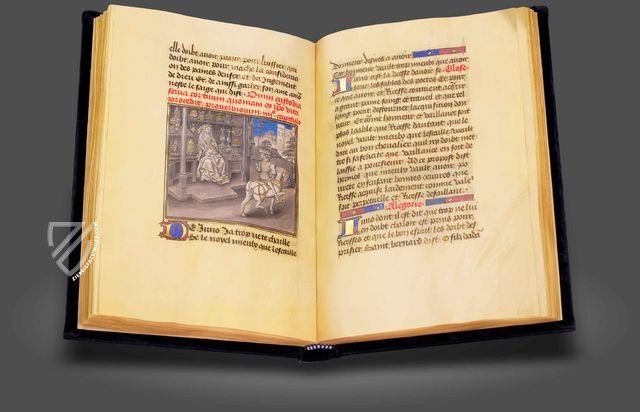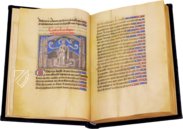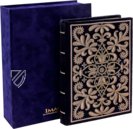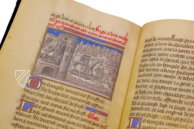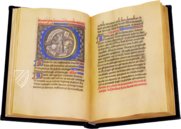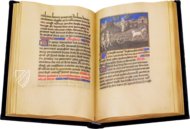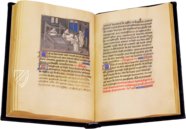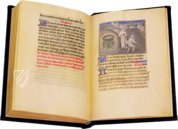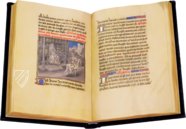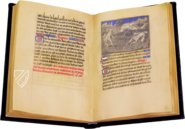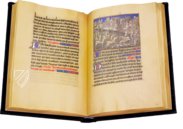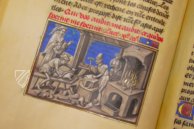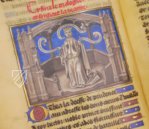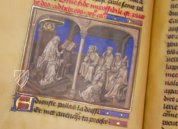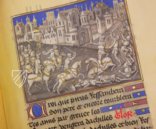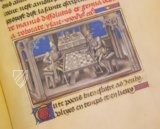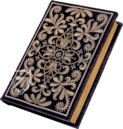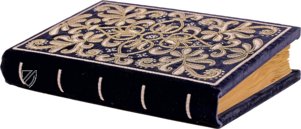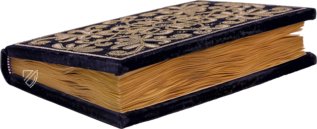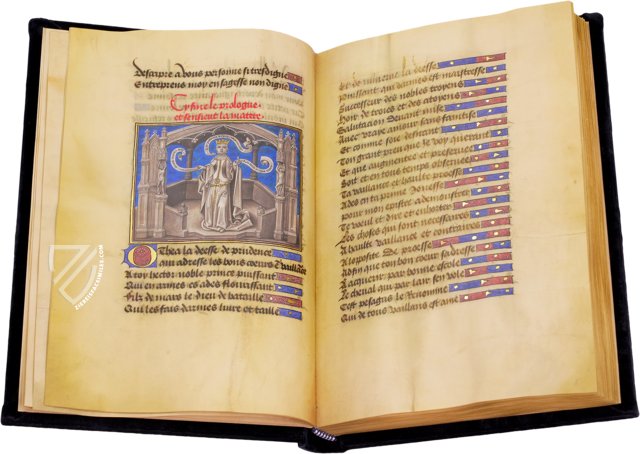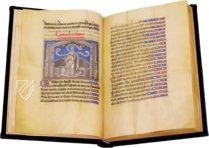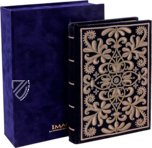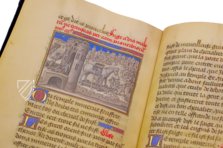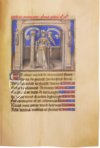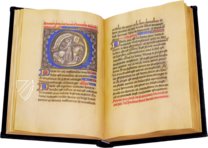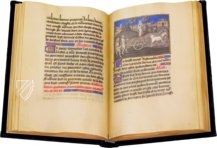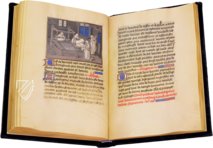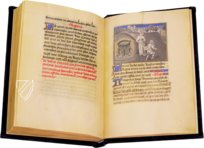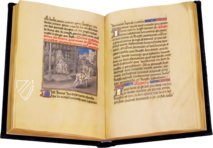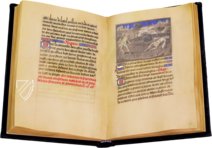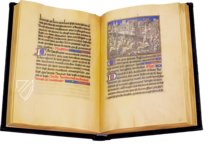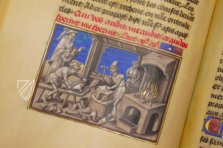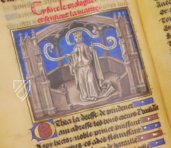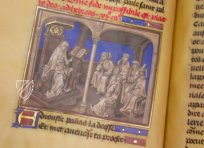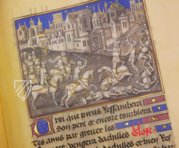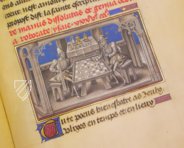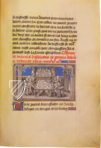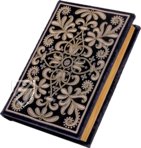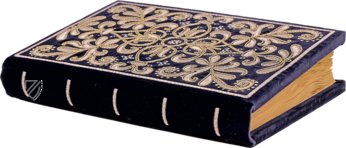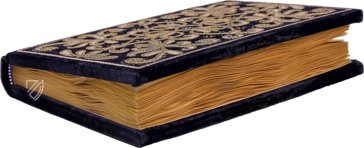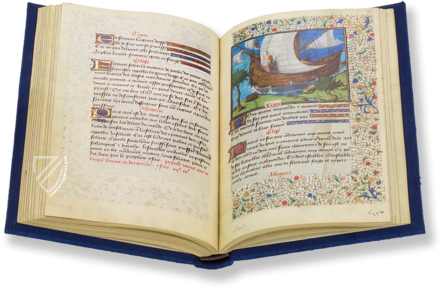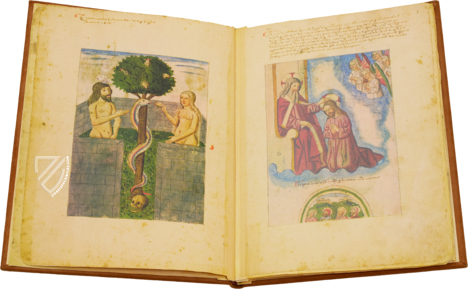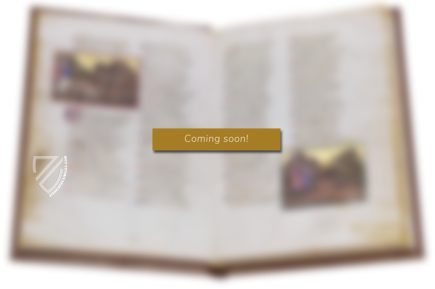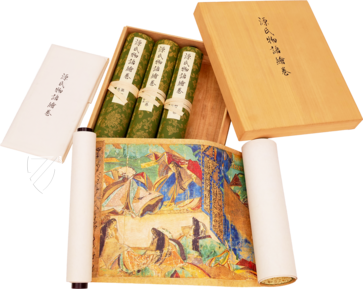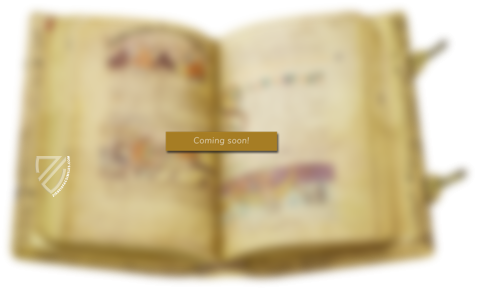Erlangen Epistle of Othéa
(3,000€ - 7,000€)
Christine de Pizan is considered to be the first independent lay female writer in Europe. She wrote her first prose work around 1400: the Letters of Othea. In 100 rhymed letters, accompanied by moralizing commentaries in prose, the fictional ancient goddess of prudence Othea gives the Trojan hero Hector a guide to true chivalry, thus providing the reader with didactic wisdom from a woman's perspective. Each letter is introduced by a large demi-grisaille miniature, richly decorated with gold leaf, which artfully illuminates the stories inspired by ancient mythology and transports them to the late Middle Ages. They were created by none other than Willem Vrelant, who worked on this precious and artistically unique manuscript on behalf of Isabella of Portugal or her son Charles the Bold.
Erlangen Epistle of Othéa
103 large, page-wide miniatures adorn this valuable copy of Christine de Pizan's (1365–1430) first prose work. In luxurious golden frames, picturesque landscapes, intricate architecture and dramatic scenes stretch out in ornate demi-grisaille paintings. Only the skies in the background stand out in intense blue, studded with golden wisps of cloud. Numerous other gold leaf details make each individual miniature an opulent little artwork on its own and the manuscript as a whole a unique example of the Letters of Othea.
Grisaille Painting by Willem Vrelant
This masterpiece was created around 1460 by the famous Dutch illuminator Willem Vrelant (1410– 481/82) and his workshop in Bruges on commission from a high-ranking member of the Burgundian court – presumably for Duke Charles the Bold (1433–1477) or his mother, Isabella of Portugal (1397–1471). At the time of writing, Charles was a young man who was soon to take over the reign of his father Philip the Good (1396–1467), and thus a suitable reader for Christine de Pizan's moralizing deliberations.
A Guide to Chivalry
The author wrote the Letters of Othea around 1400, whereupon they enjoyed great popularity and distribution already during her lifetime. In 100 short letters, the fictional ancient goddess of prudence Othea gives the fifteen-year-old Trojan hero Hector moralizing advice which, if followed, will make him a true knight. The stories draw on various ancient mythologies such as the Trojan legends and Ovid's Metamorphoses, with which de Pizan was very familiar.
A Literary Educational Manual
Each of Othea's lyrical letters is introduced by a miniature. The images thus not only serve as a decorative visualization of the stories, but are also organizational elements of the text. The letters are also each accompanied by two subsequent prose commentaries - a glossary and an allegory - as well as a suitable Biblical passage in Latin. The latter are particularly emphasized in red display script. This work of courtly literature thus embodies de Pizan's 'pre-feminist' opinion on the social role of womenpar exellence: as mothers, they were responsible for the schooling as well as the religious and moral education and upbringing of their children. As such, they not only shaped the way families lived together, but also had a considerable influence on society as a whole. Accordingly, Pizan's work provides almost maternal, but no less artful advice for a righteous life.
The Unusual Life of an Important Woman Writer
Christine de Pizan is one of the most interesting, well-known female figures of the Middle Ages and is considered the first independent female lay writer in Europe. The basis for her success as an author, which already began during her lifetime, was the comprehensive humanist education she received from an early age. Her father, a Venetian physician, astronomer and astrologer, brought the four-year-old girl to the French royal court of Charles V in 1368. The French royal court was a center of the arts, a gathering place for the most talented artists and greatest names of the time, who were brought to Paris by the art-loving rulers. This courtly environment shaped and influenced de Pizan both in her way of life and thinking as well as in her artistic work.
Due to the early deaths of her father and husband, she became a widow at the age of 25 and from then on was the only provider for her three children and her mother. Instead of following the usual path and remarrying or entering a convent, she decided to use her exceptional education to become a copyist and author. Her works included secular and sacred poetry, a biography of King Charles V, a poem on Jeanne d'Arc, autobiographical writings and, above all, philosophical and moral treatises, mainly on the role of women in society.
Codicology
- Alternative Titles
- Christine de Pizan: Erlanger Othea Briefe
Epistola di Othea
Épitre d'Othéa - Size / Format
- 252 pages / 29.3 × 20.0 cm
- Origin
- Belgium
- Date
- Ca. 1460
- Epochs
- Style
- Genre
- Language
- Script
- French littera bastarda
- Illustrations
- 103 large miniatures and 307 decorated initials
- Content
- The Epistle of Othéa by Christine de Pizan
- Patron
- Charles the Bold, Duke of Burgundy or Isabella of Portugal
- Artist / School
- Christine de Pizan (1364 – ca. 1430) (author)
Willem Vrelant (d. 1481/1482) and his workshop - Previous Owners
- Margraves of Bayreuth
- Treatises / Secular Books
- Apocalypses / Beatus
- Astronomy / Astrology
- Bestiaries
- Bibles / Gospels
- Chronicles / History / Law
- Geography / Maps
- Saints' Lives
- Islam / Oriental
- Judaism / Hebrew
- Single Leaf Collections
- Leonardo da Vinci
- Literature / Poetry
- Liturgical Manuscripts
- Medicine / Botany / Alchemy
- Music
- Mythology / Prophecies
- Psalters
- Other Religious Books
- Games / Hunting
- Private Devotion Books
- Other Genres
- Afghanistan
- Armenia
- Austria
- Belgium
- Belize
- Bosnia and Herzegovina
- China
- Colombia
- Costa Rica
- Croatia
- Cyprus
- Czech Republic
- Denmark
- Egypt
- El Salvador
- Ethiopia
- France
- Germany
- Greece
- Guatemala
- Honduras
- Hungary
- India
- Iran
- Iraq
- Israel
- Italy
- Japan
- Jordan
- Kazakhstan
- Kyrgyzstan
- Lebanon
- Liechtenstein
- Luxembourg
- Mexico
- Morocco
- Netherlands
- Palestine
- Panama
- Peru
- Poland
- Portugal
- Romania
- Russia
- Serbia
- Spain
- Sri Lanka
- Sweden
- Switzerland
- Syria
- Tajikistan
- Turkey
- Turkmenistan
- Ukraine
- United Kingdom
- United States
- Uzbekistan
- Vatican City
- A. Oosthoek, van Holkema & Warendorf
- Aboca Museum
- Ajuntament de Valencia
- Akademie Verlag
- Akademische Druck- u. Verlagsanstalt (ADEVA)
- Aldo Ausilio Editore - Bottega d’Erasmo
- Alecto Historical Editions
- Alkuin Verlag
- Almqvist & Wiksell
- Amilcare Pizzi
- Andreas & Andreas Verlagsbuchhandlung
- Archa 90
- Archiv Verlag
- Archivi Edizioni
- Arnold Verlag
- ARS
- Ars Magna
- ArtCodex
- AyN Ediciones
- Azimuth Editions
- Badenia Verlag
- Bärenreiter-Verlag
- Belser Verlag
- Belser Verlag / WK Wertkontor
- Benziger Verlag
- Bernardinum Wydawnictwo
- BiblioGemma
- Biblioteca Apostolica Vaticana (Vaticanstadt, Vaticanstadt)
- Bibliotheca Palatina Faksimile Verlag
- Bibliotheca Rara
- Boydell & Brewer
- Bramante Edizioni
- Bredius Genootschap
- Brepols Publishers
- British Library
- C. Weckesser
- Caixa Catalunya
- Canesi
- CAPSA, Ars Scriptoria
- Caratzas Brothers, Publishers
- Carus Verlag
- Casamassima Libri
- Centrum Cartographie Verlag GmbH
- Chavane Verlag
- Christian Brandstätter Verlag
- Circulo Cientifico
- Club Bibliófilo Versol
- Club du Livre
- CM Editores
- Collegium Graphicum
- Collezione Apocrifa Da Vinci
- Comissão Nacional para as Comemorações dos Descobrimentos Portugueses
- Coron Verlag
- Corvina
- CTHS
- D. S. Brewer
- Damon
- De Agostini/UTET
- De Nederlandsche Boekhandel
- De Schutter
- Deuschle & Stemmle
- Deutscher Verlag für Kunstwissenschaft
- DIAMM
- Droz
- E. Schreiber Graphische Kunstanstalten
- Ediciones Boreal
- Ediciones Grial
- Ediclube
- Edições Inapa
- Edilan
- Editalia
- Edition Deuschle
- Edition Georg Popp
- Edition Leipzig
- Edition Libri Illustri
- Editiones Reales Sitios S. L.
- Éditions de l'Oiseau Lyre
- Editions Medicina Rara
- Editorial Casariego
- Editorial Mintzoa
- Editrice Antenore
- Editrice Velar
- Edizioni Edison
- Egeria, S.L.
- Eikon Editores
- Electa
- Emery Walker Limited
- Enciclopèdia Catalana
- Eos-Verlag
- Ephesus Publishing
- Ernst Battenberg
- Eugrammia Press
- Extraordinary Editions
- Fackelverlag
- Facsimila Art & Edition
- Facsimile Editions Ltd.
- Facsimilia Art & Edition Ebert KG
- Faksimile Verlag
- Feuermann Verlag
- Folger Shakespeare Library
- Franco Cosimo Panini Editore
- Friedrich Wittig Verlag
- Fundación Hullera Vasco-Leonesa
- G. Braziller
- Gabriele Mazzotta Editore
- Gebr. Mann Verlag
- Gesellschaft für graphische Industrie
- Getty Research Institute
- Giovanni Domenico de Rossi
- Giunti Editore
- Graffiti
- Grafica European Center of Fine Arts
- Guido Pressler
- Guillermo Blazquez
- Gustav Kiepenheuer
- H. N. Abrams
- Harrassowitz
- Harvard University Press
- Helikon
- Hendrickson Publishers
- Henning Oppermann
- Herder Verlag
- Hes & De Graaf Publishers
- Hoepli
- Holbein-Verlag
- Houghton Library
- Hugo Schmidt Verlag
- Idion Verlag
- Il Bulino, edizioni d'arte
- ILte
- Imago
- Insel Verlag
- Insel-Verlag Anton Kippenberger
- Instituto de Estudios Altoaragoneses
- Instituto Nacional de Antropología e Historia
- Introligatornia Budnik Jerzy
- Istituto dell'Enciclopedia Italiana - Treccani
- Istituto Ellenico di Studi Bizantini e Postbizantini
- Istituto Geografico De Agostini
- Istituto Poligrafico e Zecca dello Stato
- Italarte Art Establishments
- Jan Thorbecke Verlag
- Johnson Reprint Corporation
- Josef Stocker
- Josef Stocker-Schmid
- Jugoslavija
- Karl W. Hiersemann
- Kasper Straube
- Kaydeda Ediciones
- Kindler Verlag / Coron Verlag
- Kodansha International Ltd.
- Konrad Kölbl Verlag
- Kurt Wolff Verlag
- La Liberia dello Stato
- La Linea Editrice
- La Meta Editore
- Lambert Schneider
- Landeskreditbank Baden-Württemberg
- Leo S. Olschki
- Les Incunables
- Liber Artis
- Library of Congress
- Libreria Musicale Italiana
- Lichtdruck
- Lito Immagine Editore
- Lumen Artis
- Lund Humphries
- M. Moleiro Editor
- Maison des Sciences de l'homme et de la société de Poitiers
- Manuscriptum
- Martinus Nijhoff
- Maruzen-Yushodo Co. Ltd.
- MASA
- Massada Publishers
- McGraw-Hill
- Metropolitan Museum of Art
- Militos
- Millennium Liber
- Müller & Schindler
- Nahar - Stavit
- Nahar and Steimatzky
- National Library of Wales
- Neri Pozza
- Nova Charta
- Oceanum Verlag
- Odeon
- Orbis Mediaevalis
- Orbis Pictus
- Österreichische Staatsdruckerei
- Oxford University Press
- Pageant Books
- Parzellers Buchverlag
- Patrimonio Ediciones
- Pattloch Verlag
- PIAF
- Pieper Verlag
- Plon-Nourrit et cie
- Poligrafiche Bolis
- Presses Universitaires de Strasbourg
- Prestel Verlag
- Princeton University Press
- Prisma Verlag
- Priuli & Verlucca, editori
- Pro Sport Verlag
- Propyläen Verlag
- Pytheas Books
- Quaternio Verlag Luzern
- Reales Sitios
- Recht-Verlag
- Reichert Verlag
- Reichsdruckerei
- Reprint Verlag
- Riehn & Reusch
- Roberto Vattori Editore
- Rosenkilde and Bagger
- Roxburghe Club
- Salerno Editrice
- Saltellus Press
- Sandoz
- Sarajevo Svjetlost
- Schöck ArtPrint Kft.
- Schulsinger Brothers
- Scolar Press
- Scrinium
- Scripta Maneant
- Scriptorium
- Shazar
- Siloé, arte y bibliofilia
- SISMEL - Edizioni del Galluzzo
- Sociedad Mexicana de Antropología
- Société des Bibliophiles & Iconophiles de Belgique
- Soncin Publishing
- Sorli Ediciones
- Stainer and Bell
- Studer
- Styria Verlag
- Sumptibus Pragopress
- Szegedi Tudomànyegyetem
- Taberna Libraria
- Tarshish Books
- Taschen
- Tempus Libri
- Testimonio Compañía Editorial
- Thames and Hudson
- The Clear Vue Publishing Partnership Limited
- The Facsimile Codex
- The Folio Society
- The Marquess of Normanby
- The Richard III and Yorkist History Trust
- Tip.Le.Co
- TouchArt
- TREC Publishing House
- TRI Publishing Co.
- Trident Editore
- Tuliba Collection
- Typis Regiae Officinae Polygraphicae
- Union Verlag Berlin
- Universidad de Granada
- University of California Press
- University of Chicago Press
- Urs Graf
- Vallecchi
- Van Wijnen
- VCH, Acta Humaniora
- VDI Verlag
- VEB Deutscher Verlag für Musik
- Verlag Anton Pustet / Andreas Verlag
- Verlag Bibliophile Drucke Josef Stocker
- Verlag der Münchner Drucke
- Verlag für Regionalgeschichte
- Verlag Styria
- Vicent Garcia Editores
- W. Turnowski Ltd.
- W. Turnowsky
- Waanders Printers
- Wiener Mechitharisten-Congregation (Wien, Österreich)
- Wissenschaftliche Buchgesellschaft
- Wissenschaftliche Verlagsgesellschaft
- Wydawnictwo Dolnoslaskie
- Xuntanza Editorial
- Zakład Narodowy
- Zollikofer AG

